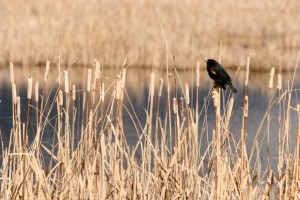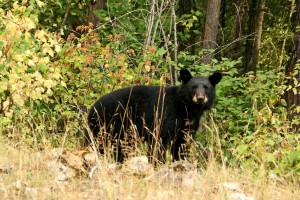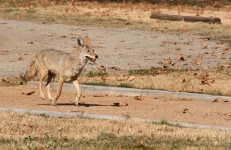Fences, stakes and lines on a map define my property from my neighbors’s property. Animal’s have property lines too but they define them differently.
Some animals, such as coyotes and bobcats, defend their territory by marking the boundaries with scat or urine. This tells other members of the same species this area is occupied.
The harsh scolding of a red squirrel lets everyone in the forest know that someone is intruding on its territory. The puffed-out display of a red-winged blackbird while calling lets another red-winged blackbird know it is intruding.
Animals establish and defend territories primarily because of food and mates. A territory ensures an adequate amount of food for an animal.
A chickadee will defend a small territory in the summer while breeding but will flock together with other birds in the winter. While flocking together, the chickadee will remain within a certain area, which is considered its home range.
All animals have a home range but not all have a territory. An animal only has a territory if it defends the area.
A home range is the area an animal uses regularly to survive. For a beaver that may mean the pond with its lodge and the surrounding forest that it fells trees in.
Animals move around their home range for food, shelter, to find a mate, care for young and to escape predators.
The size of the home range depends immensely on food abundance, habitat and the size of an animal. A wolf pack has a smaller home range when deer and elk are plentiful.
A black bear’s home range will be smaller if it occupies prime huckleberry brush. In North Idaho, a female black bear has a home range of five to 10 square miles, whereas a female grizzly bear ranges from 90 to 100 square miles.
Carnivores tend to have a larger home range than herbivores because their food source is more spread out. Herbivores, such as deer, feed on vegetation in a their home range. Carnivores, such as wolverines, prey on animals that wander about their own home ranges. Thus, a carnivore’s home range has to cover multiple home ranges of its prey.
Males typically have larger home ranges for mating purposes. A male bobcat’s territory will overlap several female’s home ranges, ensuring that other males won’t mate with the female bobcats in his home range. However, the female bobcat’s home ranges will not typically overlap.
Unlike a bobcat, female cougar home ranges can overlap, especially when it comes to the young dispersing. A young female cougar will often establish a home range that overlaps her mother’s home range.
On the other hand, young male cougars may need to travel far to find a home range without a dominant male.
Traveling to find a new home range can have mixed results. For young wolves, crossing an occupied territory can mean death, an allowance to cross or acceptance into the wolf pack.
When an animal establishes a home range, it becomes familiar with the locations of food, water, hiding spots and danger, such as a road. The animal may have one resting spot or multiple resting spots within its range, depending on the size of the home range.
The size of a home range or territory can vary year to year or season to season depending on food availability, which is why animals have a more flexible means of marking their territory than we do with fences.







